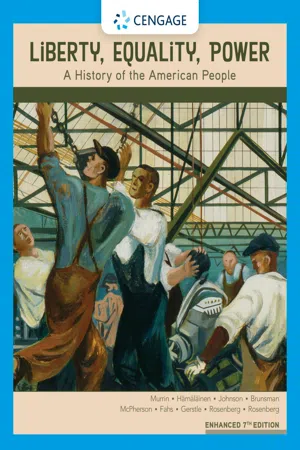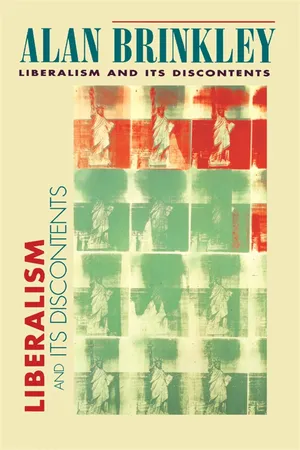History
America in WWII
America in WWII refers to the period during World War II when the United States played a significant role in the conflict. This involvement included the attack on Pearl Harbor, the mobilization of the American economy for war production, and the eventual Allied victory. The war had a profound impact on American society, economy, and global influence.
Written by Perlego with AI-assistance
Related key terms
1 of 5
3 Key excerpts on "America in WWII"
- eBook - PDF
Liberty, Equality, Power
A History of the American People, Enhanced
- John Murrin, Pekka Hämäläinen, Paul Johnson, Denver Brunsman(Authors)
- 2019(Publication Date)
- Cengage Learning EMEA(Publisher)
On the home front, see David Kennedy , The American People in World War II: Freedom from Fear (2003); Alan Winkler , Home Front U.S.A: America during World War II (3rd ed., 2012); and Gerald D. Nash , The American West Transformed: The Impact of the Second World War (1990). Maury Klein , A Call to Arms: Mobilizing America for World War II (2013), is a lengthy economic history (2013). Thomas Patrick Doherty , Projections of War: Hollywood, American Culture, and World War II (1993), examines wartime films. Melissa A. McEuen , Making Women: Femininity and Duty on the American Home Front, 1941–1945 (2011) provides an overview. Ronald Takaki , Double Victory: A Multicultural History of America in World War II (2000), examines issues of race and ethnicity. More specialized studies include Kevin Kruse and Stephen Tuck, eds. , Fog of War: The Second World War and the Civil Rights Movement (2012); and Luis Alvarez , The Power of the Zoot: Youth Culture and Resistance during World War II (2008). is a fully online personalized learning experience built upon Cengage Learning content. MindTap® combines student learning tools—readings, multimedia, activities, and assessments—into a singular Learning Path that guides students through the course and helps students develop the critical thinking, analysis, and communication skills that are essential to academic and professional success. - eBook - PDF
- Keith A. Crawford, Stuart J. Foster(Authors)
- 2011(Publication Date)
- Information Age Publishing(Publisher)
It justified fleets of carriers patrolling the Mediterranean and the South China Sea, nuclear submarines under the polar icecap, air basis in the Thai jungle, and police advisers in Uruguay and Bolivia. In support of it an average of a million sol-diers were deployed for twenty-five years in some four thousand bases in thirty countries. 2 Of course, America’s prolific engagement in world affairs has endured well beyond the 25 years to which Hodgson refers. Emerging from the ashes of World War II, America’s controversial, and self-appointed, mission to act as the world’s conscience, savior, and policeman remains highly evi-dent in the opening decade of the 21st century. The significance of World War II in understanding America’s unique place in the world cannot be underestimated. Not surprisingly, the war enjoys a prominent position in American history education. Indeed, the presence of World War II in both world and U.S. high school history curriculum is guaranteed. HISTORY TEXTBOOKS AND U.S. EDUCATION The widespread acceptance of World War II as a significant topic of study in state curricula ensures that history textbooks generously cover wartime events. The principal aim of this chapter, therefore, is to provide a critical Ideology and Narrative 127 analysis of how the war is treated in American texts. As a prerequisite to this analysis it is important to understand the role and function of history textbooks in the American educational system. Throughout their school-ing American children regularly encounter historical topics typically sup-ported by an array of mass-produced textbooks. During their high school years, students often undertake yearlong courses in both U.S. and world history. 3 To assist their study every student is issued a substantial and weighty textbook typically consisting of 750 to 1,100 pages. The selection of textbooks for use in U.S. schools is a complex and often controversial process. - eBook - PDF
- Alan Brinkley(Author)
- 2000(Publication Date)
- Harvard University Press(Publisher)
6 Legacies of World War II “The great majority of Americans,” Archibald MacLeish said in 1943, “understand very well that this war is not a war only, but an end and a beginning—an end to things known and a beginning of things un-known. We have smelled the wind in the streets that changes weather. We know that whatever the world will be when the war ends, the world will be different.” 1 Almost everyone who looked ahead to the postwar era realized, as MacLeish did, that the war had unleashed large forces that would pro-duce a new world and a new American society. But Americans greeted the prospects for change in many different ways. MacLeish—a liberal, a New Dealer, and an administrator in the wartime government—wel-comed change and believed it could be harnessed (through the efforts of an enlightened government) to the goal of creating a better and more just society. Others viewed the future with trepidation, many of them hoping to preserve the patterns of power and wealth that had shaped the world they had known before the war. The social and cultural legacy of World War II was the product of broad social forces that no individuals or institutions could ultimately control. But it was also the result of many visions of the postwar world among many groups of Americans— almost all of them certain that the war validated their often sharply different, and even conºicting, expectations. In the prologue to Six Armies in Normandy, his classic portrait of the 1944 Allied invasion of France, the historian John Keegan captured one 94 critical aspect of how the war affected the United States. He wrote of his own wartime experiences as a child in the English countryside when, a few months before D-Day, the Americans arrived. Almost overnight, he recalls, his “backwater” town ªlled with GIs.
Index pages curate the most relevant extracts from our library of academic textbooks. They’ve been created using an in-house natural language model (NLM), each adding context and meaning to key research topics.


